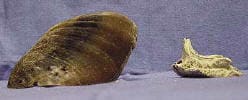
Naturalhorsetrim Listserv Photo Archives
(Click on thumbnail photos to see larger version.)
Bone studies, submitted by Anne "Tree" Coley
Conventional founder treatment
Hoof capsule and P3 taken from it. Long-term high heels can lead to severe bone
loss.
Anterial view
Bone loss involved much of this P3's tip. The largest holes belong to the
terminal arch.
Posterial view
You can see right through the left digital artery hole.
Side view from above
Although this P3 can now sit ground-parallel in its hoof capsule, it was resting
along the most forward surface area possible, the tip, now totally gone.
Fused splints calcifications
Examples of fused splint bones and excessive amounts of calcifications attached
to the upper end of the cannon bone. The left hand cannon is facing left, and
the right shows a rear view.
Another view of calcification
This cannon likely came from a bench-kneed horse. The lower joint plate fit on a
tilt which would've caused an unnatural amount of pressure to be placed where
the calcifications formed.
Remodeled P3's
Each of these P3's has remodeling in the tips, left more extreme than right. The
left one was also contracted and positioned tip down. The right one shows an
arched area leading to the palmar process and some sidebone.
P3 size study
From L to R: WB, yearling, foal and donkey (mini). The 3 on the left are all
from hind feet and the donk's was a front foot with stretched white line at the
toe.
Sidebone
Example of sidebone pulled from a hind foot hoof capsule.
P3 with hoof capsule
Note the flared outside quarter. Too much pressure for too long can cause the
lateral cartilage to calcify.
Remodeled P3
Uneven bone loss.
Cause for remodeling - lumps
Lumps discovered inside the sole surfaces. The only outward signs of trouble
were sole bruises, but outer sole appeared to be concave and even in thickness.
It wasn't.
Gravel
Damaged caused by two small pea-sized bits of gravel located within the white
line of the hoof capsule belonging to this P3.
Gravel - another view
Another view showing the damage. Bone responds to pressure. Was this horse
slaughtered due to lameness associated with the gravel? It came from a TX
slaughterhouse. A dog stole the hoof capsule while it was drying. Darn it!
Navicular bone group
Are they smiling? The sizes vary according to the animal they came from. The
holes vary depending upon the conditions they lived under.
Navicular cysts
Long-term affects of unnatural positioning. These show up as dark spots in
x-rays. The surface area you're seeing was next to the deep digital flexor
tendon.
Back to
Naturalhorsetrim list photo archives
Back to Treating Founder
without Horseshoes Homepage
Copyright by Gretchen Fathauer, 2013 All rights reserved.